m (→Amstrad CPC: image link fix) |
Trig Jegman (talk | contribs) mNo edit summary |
||
| (4 intermediate revisions by 3 users not shown) | |||
| Line 2: | Line 2: | ||
== Amstrad CPC == | == Amstrad CPC == | ||
[[ | [[File:Commando CPC.png|thumb|left|Screenshot]][[File:Commando CPC box.jpg|thumb|right|Cover]] | ||
Developed and Published by Elite Systems in the United Kingdom in 1985. | Developed and Published by Elite Systems in the United Kingdom in 1985. Rereleased by Encore in 1988. | ||
{{-}} | {{-}} | ||
== Apple II == | == Apple II == | ||
Although | Although sources claim that this version was developed by Quicksilver Software and published by Data East in 1987, there is little evidence of this version's existence, possibly due to how late it arrived in the Apple II's lifetime. | ||
{{-}} | {{-}} | ||
== Atari 2600 == | == Atari 2600 == | ||
[[ | [[File:Commando 2600.png|thumb|left|Screenshot]][[File:Commando 2600 box.jpg|thumb|right|Box art]] | ||
Ported by Imagineering Inc., and published by Activision in 1988. | Ported by Imagineering Inc., and published by Activision in 1988. Clearly the least impressive looking graphically. | ||
{{-}} | {{-}} | ||
== Atari 7800 == | == Atari 7800 == | ||
[[ | [[File:Commando 7800.png|thumb|left|Screenshot]][[File:Commando 7800 box.jpg|thumb|right|Box art]] | ||
Ported by Sculptured Software, and published by Atari in 1989. | Ported by Sculptured Software, and published by Atari in 1989. Considered quite faithful to the arcade by most accounts. Inclusion of the Pokey sound chip on the cartridge allows for a very impressive arrangement of the music from the arcade version. | ||
{{-}} | {{-}} | ||
== Atari XE == | == Atari XE == | ||
[[ | [[File:Commando AXE.png|thumb|left|Screenshot]] | ||
Ported by Sculptured Software, and due to published by Atari in 1989. | Ported by Sculptured Software, and due to published by Atari in 1989. Atari canceled the release, and the game never made it out of prototype phase, although the prototype is actually quite complete and playable. The prototype was found and made available for download on the internet in the early 2000s. | ||
{{-}} | {{-}} | ||
== Atari ST == | == Atari ST == | ||
[[ | [[File:Commando AST.png|thumb|left|Screenshot]] | ||
Developed and Published by Elite Systems in the United Kingdom in 1990. | Developed and Published by Elite Systems in the United Kingdom in 1990. A very accurate port that is only hindered by the reduction of the vertical screen height. | ||
{{-}} | {{-}} | ||
== Commodore 64 == | == Commodore 64 == | ||
[[ | [[File:Commando C64.png|thumb|left|Screenshot]][[File:Commando C64 box.jpg|thumb|right|Box art]] | ||
Developed and Published by Elite Systems in the United Kingdom in 1985. | Developed and Published by Elite Systems in the United Kingdom in 1985. Repackaged by Data East for release in the United States that same year. The Commodore 64 version's theme, a "funky" version of the arcade, was created in less than 12 hours by Rob Hubbard. The music since then has reached a cult status among Commodore 64 enthusiasts - nearly everyone who ever had a C64 knows and recognizes the tune. The cracking group (Lurid Tricycle) considered the Commodore version so easy that they added an un-trainer, to make the game harder. | ||
{{-}} | {{-}} | ||
== Commodore Amiga == | == Commodore Amiga == | ||
[[ | [[File:Commando Amiga.png|thumb|left|Screenshot]][[File:Commando Amiga box.jpg|thumb|right|Box art]] | ||
Developed by Elite Systems and published in the United States by Capcom in 1989. | Developed by Elite Systems and published in the United States by Capcom in 1989. Published by Elite Systems in the United Kingdom in 1990. By far, the most graphically accurate port of the game produced during its time. | ||
{{-}} | {{-}} | ||
== Intellivision == | == Intellivision == | ||
[[ | [[File:Commando INTV.png|thumb|left|Screenshot]][[File:Commando INTV box.jpg|thumb|right|Box art]] | ||
Ported by Realtime Associates and published by INTV in 1987. | Ported by Realtime Associates and published by INTV in 1987. | ||
Surprisingly, it is actually a pretty solid arcade conversion. The biggest strikes against it are the stiff disc controllers, and the poor graphical quality and slower pace typical of the console. The music and sound, however, are remarkably good, and up there with the best conversions of the game. One other advantage the intellivision version has over all other versions (including the arcade version) is that you can fire in sixteen directions instead of eight. When used right, this ability alone can be very advantageous. Overall, the attention to detail is much greater than the Atari 2600 version for example. | |||
{{-}} | {{-}} | ||
== MS-DOS == | == MS-DOS == | ||
[[ | [[File:Commando DOS.png|thumb|left|Screenshot]] | ||
Developed by Quicksilver Software and published by Data East in 1986. | Developed by Quicksilver Software and published by Data East in 1986. It is unknown if any version of the game could utilize EGA graphics, or if CGA was the only version available. | ||
{{-}} | {{-}} | ||
== MSX == | == MSX == | ||
[[ | [[File:Commando MSX.png|thumb|left|Screenshot]] | ||
Developed by Capcom, but published by ASCII Corporation in Japan in 1987. | Developed by Capcom, but published by ASCII Corporation in Japan in 1987. | ||
{{-}} | {{-}} | ||
== NES == | == NES == | ||
Developed and published by Capcom. | Developed and published by Capcom. It was released first in Japan, then in the United States, all within 1986. For more information about the Famicom / NES version of the game, please see the [[Commando/NES Walkthrough|NES Walkthrough page]]. | ||
<gallery> | <gallery> | ||
File:Commando NES.png|Screenshot | |||
File:Commando FC box.jpg|Famicom box | |||
File:Commando NES box.jpg|NES box | |||
</gallery> | </gallery> | ||
{{-}} | {{-}} | ||
== Sinclair ZX Spectrum == | == Sinclair ZX Spectrum == | ||
[[ | [[File:Commando SZX.png|thumb|left|Screenshot]][[File:Commando SZX box.jpg|thumb|right|Cover]] | ||
Developed and Published by Elite Systems in the United Kingdom in 1985. | Developed and Published by Elite Systems in the United Kingdom in 1985. Rereleased by Encore in 1988. | ||
{{-}} | {{-}} | ||
{{Footer Nav|game=Commando}} | {{Footer Nav|game=Commando}} | ||
Latest revision as of 16:52, 15 June 2022
Amstrad CPC[edit]
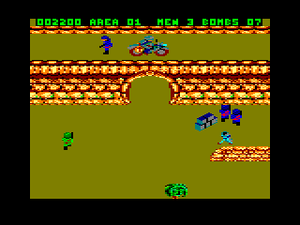
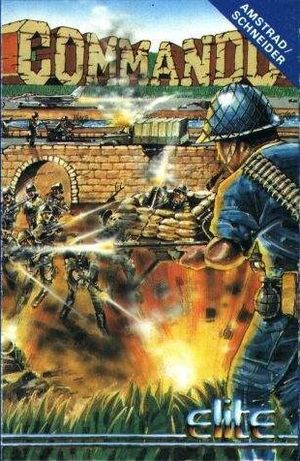
Developed and Published by Elite Systems in the United Kingdom in 1985. Rereleased by Encore in 1988.
Apple II[edit]
Although sources claim that this version was developed by Quicksilver Software and published by Data East in 1987, there is little evidence of this version's existence, possibly due to how late it arrived in the Apple II's lifetime.
Atari 2600[edit]

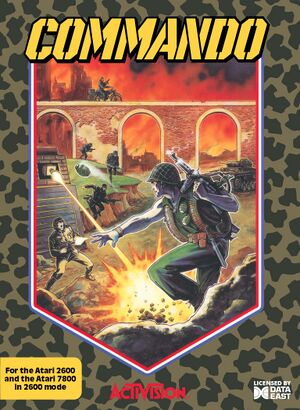
Ported by Imagineering Inc., and published by Activision in 1988. Clearly the least impressive looking graphically.
Atari 7800[edit]
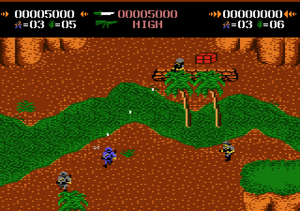

Ported by Sculptured Software, and published by Atari in 1989. Considered quite faithful to the arcade by most accounts. Inclusion of the Pokey sound chip on the cartridge allows for a very impressive arrangement of the music from the arcade version.
Atari XE[edit]
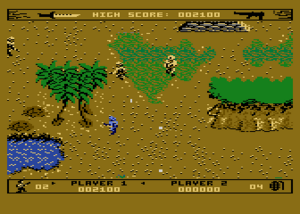
Ported by Sculptured Software, and due to published by Atari in 1989. Atari canceled the release, and the game never made it out of prototype phase, although the prototype is actually quite complete and playable. The prototype was found and made available for download on the internet in the early 2000s.
Atari ST[edit]

Developed and Published by Elite Systems in the United Kingdom in 1990. A very accurate port that is only hindered by the reduction of the vertical screen height.
Commodore 64[edit]
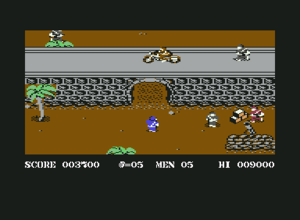

Developed and Published by Elite Systems in the United Kingdom in 1985. Repackaged by Data East for release in the United States that same year. The Commodore 64 version's theme, a "funky" version of the arcade, was created in less than 12 hours by Rob Hubbard. The music since then has reached a cult status among Commodore 64 enthusiasts - nearly everyone who ever had a C64 knows and recognizes the tune. The cracking group (Lurid Tricycle) considered the Commodore version so easy that they added an un-trainer, to make the game harder.
Commodore Amiga[edit]
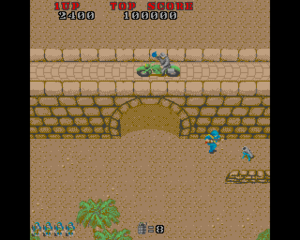

Developed by Elite Systems and published in the United States by Capcom in 1989. Published by Elite Systems in the United Kingdom in 1990. By far, the most graphically accurate port of the game produced during its time.
Intellivision[edit]

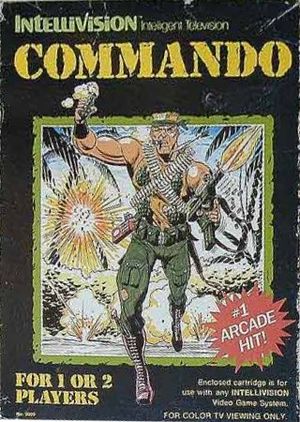
Ported by Realtime Associates and published by INTV in 1987.
Surprisingly, it is actually a pretty solid arcade conversion. The biggest strikes against it are the stiff disc controllers, and the poor graphical quality and slower pace typical of the console. The music and sound, however, are remarkably good, and up there with the best conversions of the game. One other advantage the intellivision version has over all other versions (including the arcade version) is that you can fire in sixteen directions instead of eight. When used right, this ability alone can be very advantageous. Overall, the attention to detail is much greater than the Atari 2600 version for example.
MS-DOS[edit]
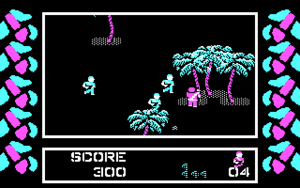
Developed by Quicksilver Software and published by Data East in 1986. It is unknown if any version of the game could utilize EGA graphics, or if CGA was the only version available.
MSX[edit]

Developed by Capcom, but published by ASCII Corporation in Japan in 1987.
NES[edit]
Developed and published by Capcom. It was released first in Japan, then in the United States, all within 1986. For more information about the Famicom / NES version of the game, please see the NES Walkthrough page.
-
Screenshot
-
Famicom box
-
NES box
Sinclair ZX Spectrum[edit]
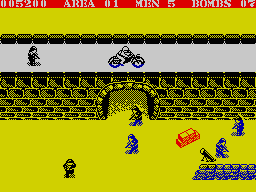
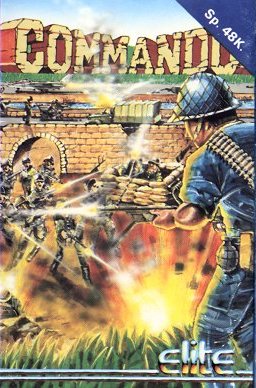
Developed and Published by Elite Systems in the United Kingdom in 1985. Rereleased by Encore in 1988.



